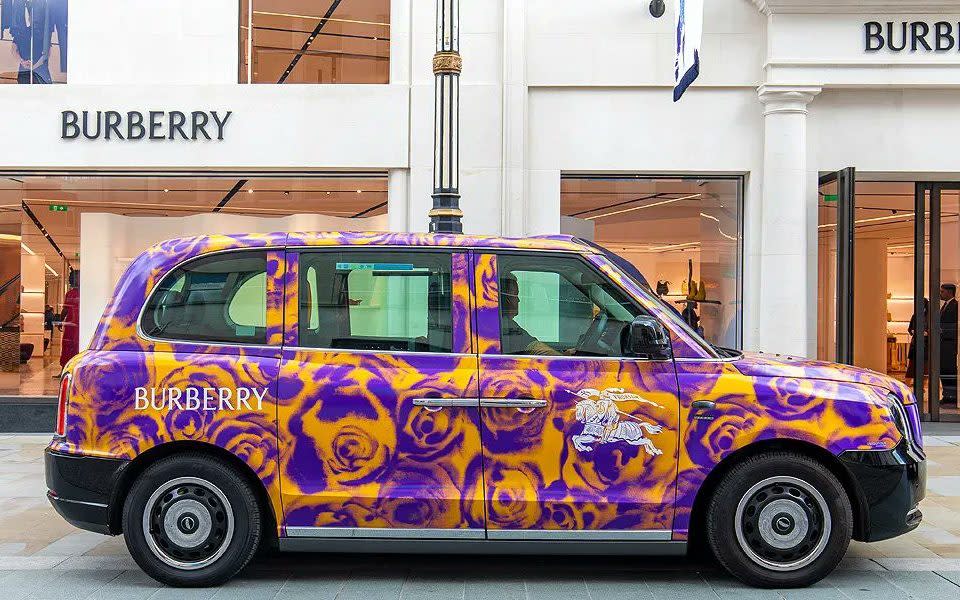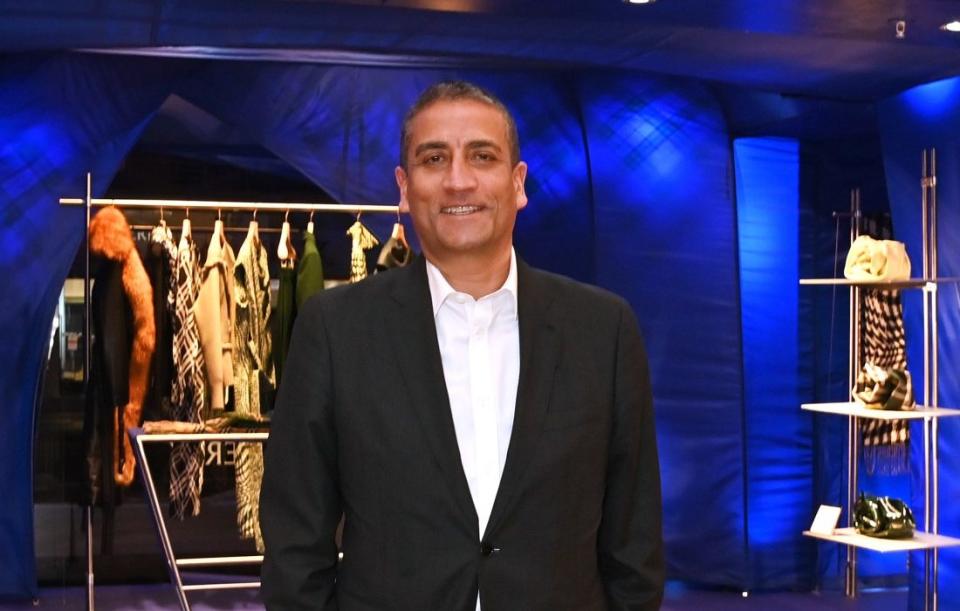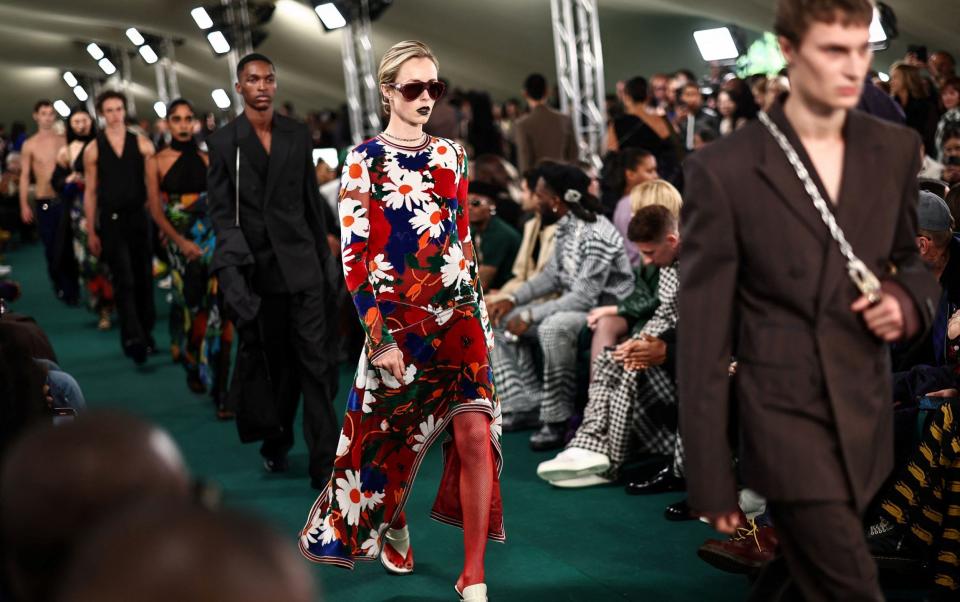In a desperate attempt to steal last September’s London Fashion Week, Burberry’s marketing team went into overdrive and planned a “takeover” of several London locations.
For a few days, Bond Street tube station became ‘Burberry Street’, the capital’s black cabs were decked out in a new Burberry-English rose motif and a popular north London greasy spoon cafe was decorated with the blue branding that has become a central feature of his more recent designs.
The stunt failed.
While new creative director Daniel Lee thought it was a clever way to channel the brand’s distinctive British roots, many Londoners were angered by what was seen as one of the most blatant examples of ‘corporation creep’.
Others saw something potentially more serious: yet more evidence of a once groundbreaking company that has lost its way.


Burberry’s struggle predates the current regime – a double act of chief executive Jonathan Akeroyd and Lee’s artistic flair – by many years. But instead of overseeing a promised return to catwalk dominance, Burberry has fallen further out of fashion.
Profits have plummeted, debts have soared and the stock price has collapsed, leaving rivals, former executives and city experts wondering where it all went wrong.
With Burberry shares languishing at £10.32 – the cheapest they have been in 12 years – there is fresh speculation describing a company as “sui generis in the context of the UK stock market” by star stock picker Nick Train is once again a takeover target for foreign predators and private equity.
There seems little doubt about who the board blames for the malaise. After revealing a 40% drop in annual profits last month, Akeroyd waived his £2.3m annual bonus, on top of his £1.1m annual salary.
Danuta Gray, chairman of Burberry’s remuneration committee, said it would not have been “appropriate” for Akeroyd to receive a bonus. In an era when rewards for failure have become all too common in boardrooms, this was a rare public censure.


The award of a bonus to financial director Kate Ferry for her “outstanding broader contribution” will have done little to ease Akeroyd’s disappointment.
The question now is whether the writing is on the wall for a man who exchanged Versace for Burberry in 2022 and received an eye-catching package.
As part of his move from Milan to London, Akeroyd was paid an upfront transfer fee of £6 million, and the opportunity to earn £11 million if certain performance measures were hit.
However, any changing of the guard at Burberry will be a decision by City grandee and chairman Gerry Murphy, whose vaunted retail acumen sees him split his time between Burberry and Tesco – where he was appointed chairman last year.
Was the departure of marketing chief Rob Hanley last week a harbinger of more high-profile exits in the coming months?
The company was recently forced to deny it was considering a possible replacement for Akeroyd after fashion blog Miss Tweed reported that Murphy had begun secretly interviewing candidates.
Burberry responded with a firm denial: “We do not comment on unsubstantiated speculation, but to be clear, Jonathan has the full support of the Burberry board.”
Some wonder if part of the problem lies with a board that is large but lightweight. “I don’t recognize anyone in it,” said a former non-executive.
Is a heavy-hitter willing to ask some tough questions?
Or is the bigger problem a lack of fashion knowledge at board level? Of the ten non-executives, only two have worked in luxury goods.
Murphy’s shopping experience is more DIY than DKNY. He led B&Q owner Kingfisher for almost five years, leaving in 2007 with the shares trading at around the same levels as when he arrived. Meanwhile, there are only two Britons left at a company where heritage is perhaps its most unique selling point – one of whom is an accountant.
Further management changes are likely to reflect poorly on Murphy. Burberry is a company that has long made a succession drama, and that has not changed since he took over from Sir John Peace in 2018.
The departure of Akeroyd’s predecessor, luxury goods veteran Marco Gobbetti in 2021, so overwhelmed the board that it appeared as if no successor was planned.
A year later, chief designer Riccardo Tisci resigned, at the same time that finance boss Julie Brown left for drug giant GSK.
On the other hand, there are serious doubts about the direction Burberry is taking under Akeroyd. In the wake of last month’s profit bomb, analysts weighed in on the company’s strategy.
Bernstein analyst Luca Solca said it was clear that Burberry was “materially underperforming competitors and the market”, adding: “Whatever the reason, the brand’s relaunch plan is not working at the moment .”
Analysts at Citibank said: “The jury is still out on whether Daniel Lee’s brand aesthetic can lead to stronger commercial success and double-digit growth.”


UBS urged clients to sell the shares, questioning whether the muted response to the brand refresh “means the turnaround may have to be more expensive to succeed”. Burberry “may need to increase spending and gross margin reinvestment,” the report said.
“Our conversations with selected wholesalers show that the price is too high, causing orders to decline year on year, while some trends on social media also do not indicate ‘hype’ among consumers,” the bank added.
Fabio Becheri, a former Gucci executive, says the problems predate Akeroyd but have been exacerbated by a decision to boost sales of handbags and other accessories.
He said: “Burberry has made crucial mistakes: Gobbetti appointed Tisci to create immediate hype but without any attention to the brand DNA, and Daniel Lee operates in a context of scaling up with an accessory-driven strategy – it is the wrong mission. ”
Akeroyd has acknowledged that the company has failed to meet expectations while criticizing the government’s so-called tourist tax for affecting spending among foreign visitors. Management has also pointed to a broader slowdown in luxury spending, especially among Chinese consumers.
Questions have been repeatedly asked about whether Burberry is overexposed to China, where it generates 30% of its sales. Can that continue in the face of rising tensions between Beijing and the West? Will Chinese shoppers still want to wear Burberry’s iconic checks the same way they used to?
Train has acknowledged that the fall in Burberry’s share price “is terrible” and called concerns about weakening Chinese demand “warranted”, but pointed out that it “has every opportunity to participate in the next upturn”.
Until that happens, Akeroyd’s ambition to grow turnover to £5 billion seems like a fantasy, especially as its most recent annual turnover fell just below £3 billion.
The struggles are in stark contrast to when Burberry wowed the catwalks in the late 1990s with a cheerful Kate Moss fronting its ad campaigns.


On a visit to the expensively renovated Bond Street store this week, there was little to suggest a return to the glory days was imminent.
On a sunny Wednesday afternoon, with only a handful of customers inside, you could see impeccably presented staff standing around looking bored. Even fewer customers left after purchasing something.
One of those who purchased – Jamie, a London-based stylist – agreed with the way designers had kept the ‘classic shape’ of their clothes while ‘making things a little more contemporary’.
Yet Sæmundur and girlfriend Tinna, both 25 years old, from Iceland, were left empty-handed and clearly disappointed: “It’s a bit expensive and it’s just not that exciting,” says Saemundur. “I’m not a big fan, I know [Tinna] loves coats…my grandma has something similar,” he adds.
As Burberry desperately tries to revive its image, it will have to convince its customers that it represents the future of fashion and not the past.
Burberry declined to comment.